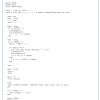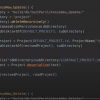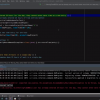 |
An Overview of Linux Exit Codes Understanding exit codes is essential for detecting errors, automating tasks, debugging issues, and facilitating inter-process communication. By mastering the key exit codes and their meanings, Linux users can effectively manage and troubleshoot their command execution and shell scripting.
|
|
 |
The 5 Most In-Demand Programming Languages of 2020 A lot of languages create a dilemma in choosing the best, so we have come up with a solution to help you get information about the five most in-demand programming languages of 2020.
|
|
 |
Switch Expressions in Java 14 add Simplicity and Agility The article discusses how the new switch statement is simplified and how the new switch expression simplifies. After setting the environment, we’ll discuss what was lacking in the switch statement that makes it less agile. Then, we’ll discuss how Java 14 simplifies switch.
|
|
 |
Clean Coding Practices for a Scalable Test Automation Framework Many organizations are looking to expand their automation abilities by designing and developing test automation frameworks. However, we often abandon good coding practices in favor of working as fast as possible. We need to treat this project like any other application development project. Here are three of the most important clean coding practices to keep in mind in order to make a scalable test automation framework.
|
|
 |
Do You Really Want to Be a Manager? The majority of managers are promoted due to their software development expertise. But becoming a successful manager requires a drastic change of focus. There is a set of expectations to consider before making that leap to the “dark side.”
|
|
 |
Playing Games to Improve Software You may not have heard about gamification, but instructional designers are now using game principles to help with retention of learned material in many forms of training. Ross Smith and Rajini Padmanaban believe that developers' UX and app design can benefit from gamification.
|
|
 |
When Software Smells Bad Most software needs to be "maintainable" and have high "internal quality." But what does that mean in practical terms? Code smells form a vocabulary for discussing code quality and how well suited code might be to change. The smells also provide good indications as to what to refactor and how.
|
|
|
|
Leveraging A Learning Culture Mistakes happen. It's how you respond to them that matters. Teams might react to a bug with panic and blame, leading to a quickly hacked fix and possibly more issues. Taking time to investigate and learn leverages problems into process and practice improvement and a higher quality product.
|
|
 |
Episode 2 - Pair Programming - Byron and Matt Discuss Generics
Video
Coveros consultants Byron Katz and Matthew Taylor continue their work on the open-source timekeeping project their team is working on. This episode is dealing more specifically with generics in the code. Technology stack: Kotlin, JVM, Intellij, Gradle Open source at https://github.com/7ep/r3z
|
|
 |
Episode 1 - Pair Programming - TDD Session with Byron and Matt from Coveros
Video
Senior Consultant Byron Katz and Consultant Matthew Taylor of Coveros test an open-source timekeeping tool project that their team is working on. Technology stack: Kotlin, JVM, Intellij, Gradle Open source at https://github.com/7ep/r3z
|
|
 |
Employ Continuous Integration Processes to Make Your Code Work: An Interview with Melissa Benua
Video
In this interview, Melissa Benua, senior backend engineer for PlayFab, explains the new way of life that continuous integration brings. She imparts practical advice for creating builds and running automation on the fly without spending hundreds of hours or thousands of dollars.
|
|
 |
Mobile Development and Aggressive Testing: An Interview with Josh Michaels
Video
Josh Michaels is an independent software developer who makes apps for the iPad, iPhone, and Mac under the company name Jetson Creative. In this interview, Josh discusses mobile development, testing aggressively, and keeping users happy.
|
|
 |
Mobbing, Pairing, Soloing, and Pipe Fires: A Personal History of Collaboration
Slideshow
Pair programming: the practice you love to hate! Twenty years after being introduced as part of Extreme Programming, the collaborative practice is still a thing. And if you thought pairing was nuts, now there's mobbing, where the entire team works together on one thing at a time. Yet we often hear teams say, "We go faster because we are mobbing." In this anecdote-heavy session, you'll hear Jeff Langr's history of working through various models for collaboration (or not) across the past several decades, including solo programming, pairing, and mobbing. He'll show you his office blueprints to help put you in his shoes and understand what contributed to the ups and downs of each model. You'll learn tips for success, pitfalls to watch out for, and Jeff's take on why mobbing or pairing might help us go faster. Come with a willingness to lose your preconceptions.
|
Jeff Langr
|
 |
A Personal History of Collaboration: Soloing, Pairing, Mobbing, Cube Farms, and Pipe Fires
Slideshow
Pair programming is the practice you love to hate! It's been nearly twenty years since Extreme Programming promoted pair programming as a collaborative practice, and it's still here. And if you thought that was bad, now there's mobbing, where the entire team works together on one thing at a time. Does that seem nuts? Yet we often hear teams say, "We go faster because we are mobbing." In this anecdote-heavy session, you'll hear Jeff Langr's history of working through various models for collaboration (or not) across the past several decades, including pairing, solo programming, and mobbing. He'll show you his office blueprints to help put you in his shoes and understand what made for the ups and downs of each model. You'll learn tips for success with each model, pitfalls to watch out for, and Jeff's take on why mobbing or pairing might help us go faster.
|
Jeff Langr
|
 |
Mobbing for Test Design: Connecting with Your Colleagues’ Test Ideas
Slideshow
Do you have trouble generating test case ideas? Are there seemingly obvious bugs getting through your test plan? Are you considering revamping your current test analysis and design? If you answered yes to any of these questions, then this session is for you. You may have heard of mob...
|
Jeff MacBane
|
 |
Threads, Queues, and More: Async Programming in iOS
Slideshow
To keep your iOS app running butter-smooth at 60 frames per second, Apple recommends doing as many tasks as possible asynchronously or “off the main thread.” Joe Keeley introduces you to some basic concepts of asynchronous programming in iOS. He discusses what threads and queues are, how...
|
Joe Keeley
|
Visit Our Other Communities
CMCrossroads is a TechWell community.
Through conferences, training, consulting, and online resources, TechWell helps you develop and deliver great software every day.
